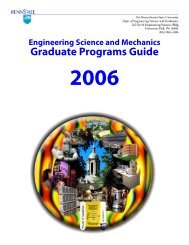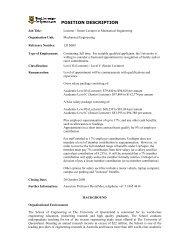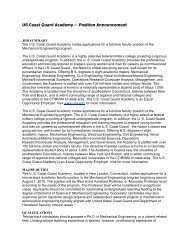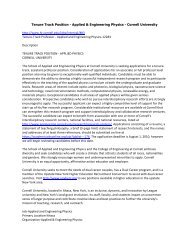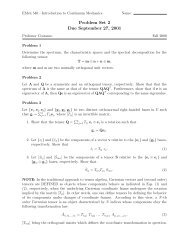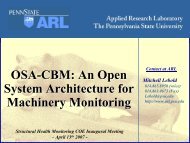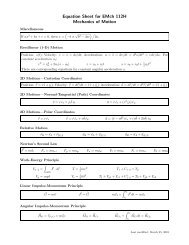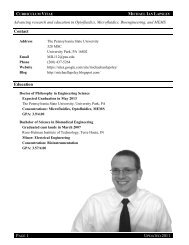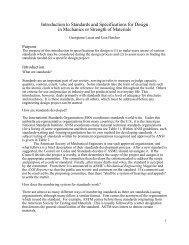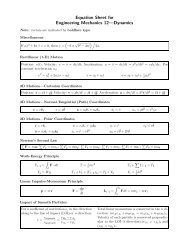Analyses of elastic waves in Aluminum/Barium sodium niobate and ...
Analyses of elastic waves in Aluminum/Barium sodium niobate and ...
Analyses of elastic waves in Aluminum/Barium sodium niobate and ...
Create successful ePaper yourself
Turn your PDF publications into a flip-book with our unique Google optimized e-Paper software.
!"#$%&'(&"")(&'$*+,")(+-.$/0-.1$2345236$724489$::$;;;$FGH-(B+,(0&.I$JA(,K")-+&L<br />
Citation M&-(&"$+N+(-+H-"$.(&B"$2448@OG'@;P<br />
&<br />
Copyright (to be <strong>in</strong>serted by the publisher)<br />
<strong>Analyses</strong> <strong>of</strong> <strong>elastic</strong> <strong>waves</strong> <strong>in</strong> Alum<strong>in</strong>um/<strong>Barium</strong> <strong>sodium</strong> <strong>niobate</strong> <strong>and</strong><br />
Quartz/Epoxy phononic structures 1<br />
Zi-Gui Huang, Tsung-Tsong Wu 1 <strong>and</strong> S. L<strong>in</strong><br />
Institute <strong>of</strong> Applied Mechanics, National Taiwan University,<br />
Taipei 106, Taiwan<br />
Keywords: Surface wave, Bulk wave, Periodic structures, Phononic crystal, B<strong>and</strong> gap<br />
Abstract. This study was aimed at us<strong>in</strong>g the theory for two-dimensional phononic crystal consist<strong>in</strong>g<br />
<strong>of</strong> materials with general anisotropy to calculate the b<strong>and</strong> gaps phenomena <strong>in</strong> Alum<strong>in</strong>um/<strong>Barium</strong><br />
<strong>sodium</strong> <strong>niobate</strong> (Y-cut) with hexagonal lattice <strong>and</strong> Quartz/Epoxy with square lattice phononic<br />
structures. Wave propagation properties <strong>of</strong> solids <strong>in</strong> which the periodic modulation occurs along the<br />
bound<strong>in</strong>g surface has been discussed <strong>in</strong> this paper. Especially surface <strong>and</strong> bulk acoustic wave<br />
properties <strong>of</strong> solids were studied <strong>in</strong> both square <strong>and</strong> hexagonal lattices consist<strong>in</strong>g <strong>of</strong> isotropic, trigonal,<br />
<strong>and</strong> orthorhombic symmetry materials. From the previous laboratory study, we confirmed that the<br />
widths <strong>of</strong> the frequency b<strong>and</strong> gap were strongly affected by the fill<strong>in</strong>g ratio, density, <strong>and</strong> <strong>elastic</strong><br />
constants match<strong>in</strong>g ratios. In this study, the results have shown that surface wave b<strong>and</strong> gaps could be<br />
found along a specific direction. In the materials we <strong>in</strong>vestigated <strong>in</strong> this paper, we found that there is<br />
no full b<strong>and</strong> gap for surface <strong>waves</strong>. Instead, full b<strong>and</strong> gap for bulk acoustic wave can be obta<strong>in</strong>ed for<br />
transverse polarization mode. Results <strong>of</strong> this paper can serve as a basis for both numerical <strong>and</strong><br />
experimental <strong>in</strong>vestigations <strong>of</strong> phononic crystal related structures.<br />
Introduction<br />
The existence <strong>of</strong> complete b<strong>and</strong> gaps <strong>of</strong> electromagnetic <strong>waves</strong> <strong>in</strong> photonic structures extend<strong>in</strong>g<br />
throughout the Brillou<strong>in</strong> zone has demonstrated a variety <strong>of</strong> fundamental <strong>and</strong> practical <strong>in</strong>terests.[1,2]<br />
This has led to a rapid grow<strong>in</strong>g <strong>in</strong>terests <strong>in</strong> the analogous acoustic effects <strong>in</strong> periodic <strong>elastic</strong> structures<br />
called the phononic crystals. Surface wave propagation on layered superlattices with traction free<br />
surface parallel to the layers has been explored extensively <strong>in</strong> the past.[3] However, <strong>in</strong>vestigations on<br />
surface wave properties <strong>of</strong> solids <strong>in</strong> which the periodic modulation occurs on the traction free surface<br />
has not started until recently.[4-8] V<strong>in</strong>ces et al.[4,5] studied experimentally the surface <strong>waves</strong><br />
generated by a l<strong>in</strong>e-focus acoustic lens at the water-loaded surfaces <strong>of</strong> a number <strong>of</strong> two-dimensional<br />
superlattices that <strong>in</strong>tersect the surface normally. Propagation <strong>of</strong> Scholte-like acoustic <strong>waves</strong> at the<br />
liquid-loaded surfaces <strong>of</strong> period structures has also been studied.[6]<br />
The superlattices considered <strong>in</strong> Refs.[4-6,8] are <strong>of</strong> isotropic materials. As for superlattices consist<br />
<strong>of</strong> anisotropic materials, Tanaka <strong>and</strong> Tamura [7] reported detail calculations for surface <strong>waves</strong> on a<br />
square superlattice consist<strong>in</strong>g <strong>of</strong> cubic materials (AlAs/GaAs) <strong>and</strong> many salient features <strong>of</strong> surface<br />
<strong>waves</strong> <strong>in</strong> two-dimensional superlattices have been described. In addition, Tanaka <strong>and</strong> Tamura[8] also<br />
reported detail calculations for surface <strong>waves</strong> on a hexagonal superlattice consist<strong>in</strong>g <strong>of</strong> isotropic<br />
materials (Al/polymer).<br />
For the analysis <strong>of</strong> bulk acoustic <strong>waves</strong> [9-15], Kushwaha et al.[9] reported the first full<br />
b<strong>and</strong>-structure calculations <strong>of</strong> the transverse polarization mode for periodic, <strong>elastic</strong> composite. In the<br />
Ref.[10], Kushwaha et al. calculated the b<strong>and</strong> structures for the transverse polarization modes <strong>of</strong><br />
nickel alloy cyl<strong>in</strong>ders <strong>in</strong> alum<strong>in</strong>um alloy host, <strong>and</strong> vice versa. They also <strong>in</strong>vestigate the dependence <strong>of</strong><br />
spectral gap on the fill<strong>in</strong>g fraction <strong>and</strong> on the material parameters. Kafesaki et al.[11] reported the<br />
multiple-scatter<strong>in</strong>g theory (MST method) for three-dimensional periodic acoustic composites.<br />
1 Correspond<strong>in</strong>g author: wutt@spr<strong>in</strong>g.iam.ntu.edu.tw<br />
!""#$%&'()#$*)*$+*,-#./#01$(#/2#3/4(*4()#/2#('%)#010*$#516#7*#$*0$/,83*,#/$#($14)5%((*,#%4#146#2/$5#/$#76#146#5*14)#9%('/8(#('*#9$%((*4#0*$5%))%/4#/2#('*<br />
087"%)'*$:#;$14)#;*3'##999-((0-4*(-#ABC:#DEF-DDF-DFG-HIJEKLMELMI>MM:DN:ENO
!!"# $%&'()*+,-(,./(%*+012)0-&*,3&'42'0-/(<br />
Title <strong>of</strong> Publication (to be <strong>in</strong>serted by the publisher)<br />
Garcia-Pablos et al.[12] used the FDTD method to <strong>in</strong>terpret experimental data for two-dimensional<br />
systems consist<strong>in</strong>g <strong>of</strong> cyl<strong>in</strong>ders <strong>of</strong> fluids (Hg, air, <strong>and</strong> oil) <strong>in</strong>serted periodically <strong>in</strong> a f<strong>in</strong>ite slab <strong>of</strong> Al<br />
host. Psarobas <strong>and</strong> Stefanou[13] calculated the b<strong>and</strong> structure <strong>of</strong> a phononic crystal consist<strong>in</strong>g <strong>of</strong><br />
complex <strong>and</strong> frequency dependent Lame’ coefficients. Zhengyou Liu et al.[14] extended the<br />
multiple-scatter<strong>in</strong>g theory for <strong>elastic</strong> <strong>waves</strong> by tak<strong>in</strong>g <strong>in</strong>to account the full vector character, <strong>and</strong><br />
presented a comparison between theory <strong>and</strong> ultrasound experiment for a hexagonal-close-packed<br />
array <strong>of</strong> steel balls immersed <strong>in</strong> water. Jun Mei et al.[15] reported the same method <strong>in</strong> Ref.[16] to<br />
extend the method <strong>in</strong> the case <strong>of</strong> cyl<strong>in</strong>ders. However, the bulk <strong>waves</strong> analysis <strong>in</strong> phononic structures<br />
among the Refs.[9-15] are <strong>of</strong> isotropic materials only.<br />
In this paper, we extended Ref.[7] to study phononic b<strong>and</strong> gaps <strong>of</strong> <strong>elastic</strong>/acoustic <strong>waves</strong> <strong>in</strong><br />
two-dimensional Alum<strong>in</strong>um/<strong>Barium</strong> <strong>sodium</strong> <strong>niobate</strong> (Y-cut) (Ba2NaNb5O15) with hexagonal lattice<br />
<strong>and</strong> Quartz/Epoxy with square lattice phononic structures. The explicit formulations <strong>of</strong> the plane<br />
harmonic bulk wave <strong>and</strong> the surface wave dispersion relations <strong>in</strong> such a general phononic structure<br />
are discussed based on the plane wave expansion method.<br />
Equations <strong>of</strong> Motion <strong>of</strong> 2-D Phononic Crystals<br />
In an <strong>in</strong>homogeneous l<strong>in</strong>ear <strong>elastic</strong> anisotropic medium with no body force, the equation <strong>of</strong> motion for<br />
the displacement vector u ( r ,t ) can be written as<br />
ρ ( r) <br />
( r,<br />
t)<br />
= ∂ [ C ( r)<br />
∂ u ( r,<br />
t)]<br />
(1)<br />
ui j ijmn n m<br />
where r = ( x,<br />
z ) = ( x,<br />
y,<br />
z)<br />
is the position vector, ρ( r ) , C (r) are the position-dependent mass<br />
density <strong>and</strong> <strong>elastic</strong> stiffness tensor, respectively. In the follow<strong>in</strong>g, we consider a phononic crystal<br />
composed <strong>of</strong> a two dimensional periodic array (x-y plane) <strong>of</strong> material A embedded <strong>in</strong> a background<br />
material B. Due to the spatial periodicity, the material constants, ρ( x ) , C ( x ) can be exp<strong>and</strong>ed <strong>in</strong><br />
the Fourier series with respect to the two-dimensional reciprocal lattice vectors (RLV), G = ( G1, G2<br />
) ,<br />
as<br />
G x<br />
ρ x ρ<br />
⋅ i<br />
( ) = e<br />
(2)<br />
G<br />
G<br />
iG<br />
x ijmn<br />
ijmn x e C<br />
G<br />
⋅<br />
( ) =<br />
(3)<br />
ijmn<br />
C G<br />
where ρG <strong>and</strong> CG are the correspond<strong>in</strong>g Fourier coefficients.<br />
On utiliz<strong>in</strong>g the Bloch theorem <strong>and</strong> exp<strong>and</strong><strong>in</strong>g the displacement vector u( r , t)<br />
<strong>in</strong> Fourier series for<br />
bulk wave analysis, we have<br />
u(<br />
r,<br />
t)<br />
ik⋅x−iωt iG⋅x<br />
ikz<br />
z<br />
e<br />
( e AGe<br />
)<br />
(4)<br />
=<br />
G<br />
k = ( k1,<br />
k2<br />
is the Bloch wave vector, ω is the circular frequency <strong>and</strong> z<br />
where )<br />
k is the wave number<br />
along the z-direction, AG is the amplitude <strong>of</strong> the displacement vector. We note that as the component<br />
<strong>of</strong> the wave vector k z equals to zero, Eq. (6) degenerates <strong>in</strong>to the displacement vector <strong>of</strong> a bulk<br />
acoustic wave.<br />
Substitut<strong>in</strong>g Eqs. (2), (3) <strong>and</strong> (4) <strong>in</strong>to Eq. (1), <strong>and</strong> after collect<strong>in</strong>g terms systematically, we obta<strong>in</strong><br />
the generalized eigenvalue problem<br />
2<br />
( Ak z + Bk<br />
z + C)<br />
U = 0<br />
(5)<br />
where A, B <strong>and</strong> C are 3n× 3n<br />
matrices <strong>and</strong> are functions <strong>of</strong> the Bloch wave vector k , components <strong>of</strong><br />
the two-dimensional RLV, circular frequency ω, the Fourier coefficients <strong>of</strong> mass density ρ G <strong>and</strong><br />
components <strong>of</strong> <strong>elastic</strong> stiffness tensor<br />
expansion <strong>and</strong><br />
listed <strong>in</strong> Ref.[18, 19].<br />
ijmn<br />
ijmn<br />
CG . n is the total number <strong>of</strong> RLV used <strong>in</strong> the Fourier<br />
1 2 3 T<br />
U = [ A ' A ' A ' ] is the displacement vector. The expressions <strong>of</strong> the matrices are<br />
G G G<br />
ijmn
Title <strong>of</strong> Publication (to be <strong>in</strong>serted by the publisher)<br />
Eq. (5) is more complicated than that <strong>of</strong> the two-dimensional phononic crystal with cubic<br />
symmetry given by Tanaka <strong>and</strong> Tamura [7] <strong>in</strong> such a way that the coefficient matrix B is not vanished.<br />
However, it can be solved by <strong>in</strong>troduc<strong>in</strong>g V = k zU<br />
<strong>and</strong> rewritten <strong>in</strong> the form as[9]<br />
0 I U<br />
U<br />
<br />
<br />
= k<br />
−<br />
−<br />
z <br />
(6)<br />
1 1<br />
−<br />
A C − A BV<br />
V<br />
Bulk <strong>and</strong> Surface Waves <strong>in</strong> 2-D Phononic Crystals<br />
It is worth not<strong>in</strong>g that the case <strong>of</strong> bulk wave is a special case <strong>of</strong> Eq. (5). When k z <strong>in</strong> Eq. (5) is equal to<br />
zero, the equation degenerates <strong>in</strong>to the eigenvalue problem <strong>of</strong> bulk <strong>waves</strong> as<br />
CU = 0<br />
(7)<br />
The dispersion relations <strong>of</strong> bulk <strong>waves</strong> propagat<strong>in</strong>g <strong>in</strong> two-dimensional phononic crystals with both<br />
the fill<strong>in</strong>g material <strong>and</strong> the background material belong to the tricl<strong>in</strong>ic system; can be obta<strong>in</strong>ed by<br />
sett<strong>in</strong>g the determ<strong>in</strong>ant <strong>of</strong> matrix C equal to zero.<br />
For material with symmetry higher (<strong>and</strong> equal to) than orthorhombic symmetry, the matrix C can<br />
be decoupled <strong>in</strong>to two different polarization modes as<br />
(1) 2 (1) (1) 1<br />
M ′ ω R ′ L ′ <br />
G,G − G,G G,G A ′ G<br />
0<br />
(2) (2) 2 (2) 2 =<br />
(8)<br />
LG,G′ M G,G′ −ω RG,G′ AG ′ <br />
for mixed polarization modes (i.e., longitud<strong>in</strong>al (L) <strong>and</strong> shear horizontal (SH)) <strong>and</strong><br />
(3) 2 (3) 3<br />
M − ω R A = 0<br />
G,G′ G,G′ G ′ <br />
(9)<br />
for shear vertical (SV) modes with polarization <strong>of</strong> the displacement along the z direction (i.e., the<br />
filler’s length direction). The expressions <strong>of</strong> the components <strong>in</strong> Eqs.(8) <strong>and</strong> (9) are listed <strong>in</strong> Ref.[18,<br />
19].<br />
It is worth not<strong>in</strong>g that for material with symmetry lower than orthorhombic symmetry, the matrix C<br />
can’t be decoupled <strong>in</strong>to two different polarization modes. The full matrix C must be considered <strong>and</strong><br />
dist<strong>in</strong>guish different modes as quasi shear vertical modes, quasi shear horizontal modes <strong>and</strong> quasi<br />
longitud<strong>in</strong>al modes.<br />
(l )<br />
For the case <strong>of</strong> surface wave, the 6n eigenvalues k z <strong>of</strong> Eq. (6) are the apparent wave numbers <strong>of</strong><br />
the plane <strong>waves</strong> <strong>in</strong> the z direction. Accord<strong>in</strong>g to the exponential dependence <strong>of</strong> z <strong>in</strong> Eq. (4), the real<br />
(l )<br />
part <strong>of</strong> k z denotes the plane wave propagation <strong>in</strong> the z direction, <strong>and</strong> a positive nonvanish<strong>in</strong>g<br />
imag<strong>in</strong>ary part represents attenuation <strong>in</strong> the z direction. For surface <strong>waves</strong> propagate <strong>in</strong> a half space (z<br />
(l )<br />
> 0), only 3n eigenvalues, which attenuate <strong>in</strong> the positive z direction are chosen, i.e., Im ( k z ) > 0.<br />
Accord<strong>in</strong>gly, the surface wave displacement can be expressed as<br />
3n<br />
<br />
( l )<br />
' i(<br />
k+<br />
G)<br />
⋅x−iωt<br />
ik z z<br />
u(<br />
r,<br />
t)<br />
= e <br />
AGe<br />
<br />
G l=<br />
1 <br />
(10)<br />
3n<br />
i k+<br />
G ⋅x−i<br />
t <br />
( l )<br />
' ( ) ω<br />
( l ) ik z z<br />
= e <br />
X l<br />
G e <br />
G l=<br />
1 <br />
(l )<br />
)<br />
where<br />
is the associated eigenvector <strong>of</strong> the eigenvalue k . The prime <strong>of</strong> the summation denotes<br />
G<br />
5*6,3(7-(**1-(7,8'0*1-'4+,9/4+:,";#
!!"" $%&'()*+,-(,./(%*+012)0-&*,3&'42'0-/(<br />
H<br />
<br />
H<br />
<br />
H<br />
( 1)<br />
1,<br />
G<br />
( 1)<br />
2,<br />
G<br />
( 1)<br />
3,<br />
G<br />
H<br />
H<br />
H<br />
( 2)<br />
1,<br />
G<br />
( 2)<br />
2,<br />
G<br />
( 2)<br />
3,<br />
G<br />
<br />
<br />
<br />
Title <strong>of</strong> Publication (to be <strong>in</strong>serted by the publisher)<br />
H<br />
H<br />
H<br />
( 3n)<br />
1,<br />
G<br />
( 3n)<br />
2,<br />
G<br />
( 3n)<br />
3,<br />
G<br />
X 1 <br />
<br />
<br />
<br />
X 2 ~<br />
≡ HX<br />
= 0<br />
<br />
<br />
<br />
<br />
X<br />
3n<br />
<br />
where H ~ is a 3n×3n matrix <strong>and</strong> its components are listed <strong>in</strong> Ref.[18, 19].<br />
For the existence <strong>of</strong> a nontrivial solution <strong>of</strong> X l , the follow<strong>in</strong>g condition must be satisfied, i.e.,<br />
~<br />
det( H ) = 0<br />
(13)<br />
Eq. (13) is the dispersion relation for surface <strong>waves</strong> propagat<strong>in</strong>g <strong>in</strong> two-dimensional phononic<br />
crystals with both the fill<strong>in</strong>g material <strong>and</strong> the background material belong to the tricl<strong>in</strong>ic system. The<br />
relative magnitude <strong>of</strong> the eigenvectors X l can be obta<strong>in</strong>ed by substitut<strong>in</strong>g k z <strong>and</strong> ω, which satisfy Eq.<br />
(13), <strong>in</strong>to Eq. (12).<br />
Numerical Examples<br />
The Fourier coefficients, ρ G <strong>and</strong><br />
ijmn<br />
CG <strong>in</strong> Eqs. (2) <strong>and</strong> (3), can be expressed as<br />
α<br />
A f + α B ( 1−<br />
f )<br />
α G = <br />
(<br />
α A −α<br />
B ) FG<br />
for G = 0<br />
for G ≠ 0<br />
(14)<br />
ijmn<br />
where α = ( ρ,<br />
C ) , f is the fill<strong>in</strong>g fraction that def<strong>in</strong>es the cross-sectional area <strong>of</strong> a cyl<strong>in</strong>der relative<br />
to a unit-cell area, <strong>and</strong> FG is called the structure function def<strong>in</strong>ed as<br />
2 fJ1<br />
( Gr0<br />
)<br />
F G =<br />
Gr<br />
(15)<br />
0<br />
with J 1( x)<br />
a first order Bessel function.<br />
In this paper, phononic structures with square lattice <strong>and</strong> hexagonal lattice are considered. These<br />
lattices are consist<strong>in</strong>g <strong>of</strong> circular cyl<strong>in</strong>ders (A) embedded <strong>in</strong> a background material (B) form<strong>in</strong>g<br />
two-dimensional lattices with lattice spac<strong>in</strong>g a as shown <strong>in</strong> Fig. 1a (square lattice) <strong>and</strong> Fig. 1b<br />
(hexagonal lattice). Figs. 2a <strong>and</strong> 2b are the Brillou<strong>in</strong> regions <strong>of</strong> the square lattice <strong>and</strong> the hexagonal<br />
G = πN<br />
/ a,<br />
2πN<br />
/ a ,<br />
lattice, respectively. In the square lattice, the reciprocal lattice vector is ( )<br />
2 1<br />
2<br />
where N1 , N 2 = 0,<br />
± 1,<br />
± 2,<br />
<strong>and</strong> fill<strong>in</strong>g fraction is<br />
2 2<br />
f = ( πr0<br />
) / a . For anisotropic materials, the<br />
irreducible part <strong>of</strong> the Brillou<strong>in</strong> zone <strong>of</strong> a square lattice is shown <strong>in</strong> Fig. 2a, which is a square with<br />
vertexes Γ, X, M, Y. The reciprocal lattice vector <strong>of</strong> a hexagonal lattice is<br />
G = πN<br />
/ a,<br />
2π<br />
( 2N<br />
− N ) / 3a<br />
, where N N = 0,<br />
± 1,<br />
± 2,<br />
<strong>and</strong> fill<strong>in</strong>g fraction is<br />
( )<br />
2 1<br />
2 1<br />
2 2<br />
( 2 r ) / 3a<br />
0<br />
1 , 2<br />
f = π . The irreducible part <strong>of</strong> the Brillou<strong>in</strong> zone <strong>of</strong> a hexagonal lattice is shown <strong>in</strong> Fig. 2b,<br />
which is a quadrangle with vertexes Γ, K, L, Y. The <strong>elastic</strong> properties <strong>of</strong> the materials utilized <strong>in</strong> the<br />
follow<strong>in</strong>g examples are adopted from Ref.[17].<br />
In this paper, we consider a phononic structure consist<strong>in</strong>g <strong>of</strong> circular cyl<strong>in</strong>ders <strong>of</strong> Al embedded<br />
<strong>in</strong> a background material <strong>of</strong> Y-cut barium <strong>sodium</strong> <strong>niobate</strong> form<strong>in</strong>g a two-dimensional hexagonal<br />
lattice. The material <strong>of</strong> the fill<strong>in</strong>g cyl<strong>in</strong>ders is isotropic alum<strong>in</strong>um <strong>and</strong> the base material is barium<br />
<strong>sodium</strong> <strong>niobate</strong> with orthorhombic symmetry. In the follow<strong>in</strong>g calculations, the x-z plane is parallel to<br />
the (001) plane <strong>and</strong> the x-axis is parallel to the [100] direction <strong>of</strong> barium <strong>sodium</strong> <strong>niobate</strong>. The fill<strong>in</strong>g<br />
fraction is f = 0.6.<br />
Shown <strong>in</strong> Figure 3 are the dispersion curves <strong>of</strong> the bulk modes <strong>and</strong> surface acoustic modes <strong>of</strong> the<br />
Al/<strong>Barium</strong> <strong>sodium</strong> <strong>niobate</strong> (Y-cut) phononic structure with hexagonal lattice. The vertical axis is the<br />
normalized frequency t C<br />
* *<br />
ω = ωa<br />
/ <strong>and</strong> the horizontal axis is the reduced wave number k = ka / π .<br />
As the <strong>elastic</strong> <strong>waves</strong> propagate along the x axis, the nonvanish<strong>in</strong>g displacement <strong>of</strong> the shear<br />
horizontal mode, shear vertical mode <strong>and</strong> longitud<strong>in</strong>al mode are uy, uz, <strong>and</strong> ux respectively. For the<br />
(12)
5*6,3(7-(**1-(7,8'0*1-'4+,9/4+:,";#
!!"> $%&'()*+,-(,./(%*+012)0-&*,3&'42'0-/(<br />
Normalized Frequency (ωa/C t )<br />
4.5<br />
4<br />
3.5<br />
3<br />
2.5<br />
2<br />
1.5<br />
1<br />
0.5<br />
Title <strong>of</strong> Publication (to be <strong>in</strong>serted by the publisher)<br />
L<br />
SV 0<br />
SV 1<br />
SAW<br />
PSAW<br />
SH 0<br />
SH 1<br />
SAW modes<br />
PSAW modes<br />
Shear horizontal modes (SH0)<br />
Higher shear horizontal modes (SH1)<br />
Longitud<strong>in</strong>al modes (L)<br />
Shear vertical modes (SV0, SV1)<br />
0<br />
Γ K L Y<br />
Reduced Wave Vector (ka/π)<br />
Fig. 3. Dispersion Relations <strong>of</strong> BAW & SAW modes (Al/<strong>Barium</strong> <strong>sodium</strong> <strong>niobate</strong><br />
(Y-cut), f = 0.6, Hex.)<br />
Fig. 4. Dispersion Relations <strong>of</strong> BAW modes (Quartz/Epoxy, f = 0.426, Sq.)<br />
sequence modes appear, we dist<strong>in</strong>guish the same type mode as the fundamental, the first <strong>and</strong> the<br />
second modes et al. For example <strong>in</strong> Figure 3, the th<strong>in</strong> solid l<strong>in</strong>es represent the SV bulk acoustic modes<br />
(the fundamental mode is SV0 <strong>and</strong> the first mode is SV1), <strong>and</strong> the square symbols are those for the<br />
longitud<strong>in</strong>al mode (L). The th<strong>in</strong> dashed l<strong>in</strong>e represents the fundamental shear horizontal mode SH0,<br />
while the l<strong>in</strong>es with “+” symbols represent the first shear horizontal mode SH1. The longitud<strong>in</strong>al<br />
modes L are shown as square symbols. It is seen that the dispersion relations <strong>in</strong> K-L section are almost<br />
symmetric respect to the center <strong>of</strong> the section (M po<strong>in</strong>t <strong>in</strong> Fig.2(b)). It is worth not<strong>in</strong>g that <strong>in</strong> the L-Y<br />
section, sharp bends <strong>of</strong> the dispersion curves occur between SH1 <strong>and</strong> L modes (T1 po<strong>in</strong>t) <strong>and</strong> between<br />
T 1<br />
T 2<br />
Γ
Title <strong>of</strong> Publication (to be <strong>in</strong>serted by the publisher)<br />
L <strong>and</strong> SH0 modes (T2 po<strong>in</strong>t). Therefore, there are mode conversions (SH <strong>and</strong> L) exist <strong>in</strong> this phononic<br />
structure with hexagonal lattice.<br />
From Figure 3, the solid circles represent the dispersion relations <strong>of</strong> the surface wave modes<br />
(SAW) <strong>and</strong> the open circles are those for the pseudo-surface wave (PSAW) modes. For the<br />
convenience <strong>in</strong> discuss<strong>in</strong>g the <strong>in</strong>teraction <strong>of</strong> the surface wave <strong>and</strong> bulk wave, the dispersion <strong>of</strong> the<br />
surface <strong>and</strong> bulk modes are shown <strong>in</strong> the same figure. Result showed that as the normalized frequency<br />
<strong>of</strong> the surface wave mode lies between the SH0 <strong>and</strong> SH1 modes, the surface wave degenerates <strong>in</strong>to the<br />
pseudo-surface wave mode. Unlike the normal surface wave mode, the displacement <strong>of</strong> the<br />
pseudo-surface wave mode does not decay to zero at large depth. In the present case, one f<strong>in</strong>ds that at<br />
K po<strong>in</strong>t, there is no surface wave b<strong>and</strong> gap existed. However, along the Γ -Y boundary, a<br />
PSAW-PSAW b<strong>and</strong> gap exists at the boundary po<strong>in</strong>t Y. The phenomenon showed the characteristics<br />
<strong>of</strong> an anisotropic material.<br />
In the second example, we consider a phononic structure consist<strong>in</strong>g <strong>of</strong> quartz circular cyl<strong>in</strong>ders<br />
embedded <strong>in</strong> a background epoxy material <strong>of</strong> form<strong>in</strong>g a two-dimensional square lattice with lattice<br />
spac<strong>in</strong>g a . Figure 4 shows the dispersion relations <strong>of</strong> all bulk <strong>waves</strong> along the boundaries <strong>of</strong> the<br />
irreducible part <strong>of</strong> the Brillou<strong>in</strong> zone with fill<strong>in</strong>g ratio f = 0.426. For the quartz cyl<strong>in</strong>ders, the matrix C<br />
<strong>in</strong> Eq. (7) can’t be decoupled <strong>in</strong>to mixed polarization modes <strong>and</strong> transverse polarization modes. The<br />
similar modes for the different polarizations <strong>in</strong> this phononic structure are dist<strong>in</strong>guished as quasi<br />
shear vertical modes, quasi shear horizontal modes <strong>and</strong> quasi longitud<strong>in</strong>al mode. In Figure 4, the<br />
vertical axis is the normalized frequency <strong>and</strong> the horizontal axis is the reduced wave number<br />
propagat<strong>in</strong>g along full Brillou<strong>in</strong> zone <strong>of</strong> a square lattice shown <strong>in</strong> Figure 2(a). The square symbols<br />
represent the quasi longitud<strong>in</strong>al modes <strong>and</strong> quasi shear horizontal modes. The solid circles represent<br />
the dispersion relations <strong>of</strong> quasi shear vertical modes. We can f<strong>in</strong>d that there are three total b<strong>and</strong> gaps<br />
between quasi SV0 <strong>and</strong> quasi SV1, between quasi SV2 <strong>and</strong> quasi SV3, <strong>and</strong> between quasi SV4 <strong>and</strong><br />
quasi SV5 <strong>in</strong> the normalized frequency range *<br />
ω = 0 ~ 40 .<br />
Conclusion<br />
In this paper, we studied the phononic b<strong>and</strong> gaps <strong>of</strong> surface <strong>waves</strong> <strong>and</strong> bulk <strong>waves</strong> <strong>in</strong> two-dimensional<br />
phononic structures consisted <strong>of</strong> general anisotropic materials. The explicit formulations <strong>of</strong> the plane<br />
harmonic bulk wave <strong>and</strong> the surface wave dispersion relations <strong>in</strong> such a general phononic structure<br />
are derived based on the plane wave expansion method. Al/<strong>Barium</strong> <strong>sodium</strong> <strong>niobate</strong> (Y-cut) phononic<br />
structure with hexagonal lattice <strong>and</strong> Quartz/Epoxy phononic structure with square lattice are<br />
considered <strong>in</strong> the numerical examples. Total b<strong>and</strong> gap characteristics <strong>of</strong> the phononic structures with<br />
anisotropic materials are calculated <strong>and</strong> discussed. It is worth not<strong>in</strong>g that some <strong>of</strong> the cross<strong>in</strong>g over <strong>of</strong><br />
the dispersion curves (apparently) is <strong>in</strong>deed sharp bends <strong>of</strong> the dispersion curves. Around this sharp<br />
bend area, the mode exchange suddenly. Results <strong>of</strong> this paper can serve as a basis for both numerical<br />
<strong>and</strong> experimental <strong>in</strong>vestigations <strong>of</strong> phononic crystal structures consisted <strong>of</strong> general anisotropic<br />
materials.<br />
Acknowledgments<br />
The authors thank the f<strong>in</strong>ancial supports <strong>of</strong> this research from the National Science Council <strong>of</strong><br />
Taiwan, Academia S<strong>in</strong>ica <strong>of</strong> Taiwan <strong>and</strong> the NTU-ITRI center.<br />
References<br />
5*6,3(7-(**1-(7,8'0*1-'4+,9/4+:,";#
!!"@ $%&'()*+,-(,./(%*+012)0-&*,3&'42'0-/(<br />
Title <strong>of</strong> Publication (to be <strong>in</strong>serted by the publisher)<br />
[3] T. Aono <strong>and</strong> S. Tamura, Phys. Rev. B 58, 4838, (1998).<br />
[4] R.E V<strong>in</strong>es, J.P. Wolfe, <strong>and</strong> A. G. Every, Phys. Rev. B 60, 11871, (1999).<br />
[5] R.E V<strong>in</strong>es <strong>and</strong> J.P. Wolfe, Physica B 263-264, 567, (1999).<br />
[6] A.G. Every, R.E. V<strong>in</strong>es <strong>and</strong> J.P. Wolfe, Phys. Rev. B 60, 11755, (1999).<br />
[7] Y. Tanaka <strong>and</strong> S. Tamura, Phys. Rev. B 58, 7958, (1998).<br />
[8] Y. Tanaka <strong>and</strong> S. Tamura, Phys. Rev. B 60, 13 294, (1999).<br />
[9] M.S. Kushwaha, P. Halevi, L. Dobrzynski, <strong>and</strong> B. Djafari-Rouhani, Phys. Rev. Lett. 71, 2022,<br />
(1993).<br />
[10] M.S. Kushwaha, P. Halevi, G. Mart<strong>in</strong>ez, L. Dobrzynski, <strong>and</strong> B. Djafari-Rouhani, Phys. Rev. B<br />
49, 2313, (1994).<br />
[11] M. Kafesaki <strong>and</strong> E.N. Economou, Phys. Rev. B 60, 11993, (1999).<br />
[12] D. Garica-Pablos, M. Sigalas, F.R. Montero de Esp<strong>in</strong>osa, M. Kafesaki <strong>and</strong> N. Garcia, Phys. Rev.<br />
Lett. 84, 4349, (2000).<br />
[13] I.E. Psarobas <strong>and</strong> N. Stefanou, Phys. Rev. B 62, 278, (2000).<br />
[14] Zhengyou Liu, C.T. Chan, <strong>and</strong> P<strong>in</strong>g Sheng, Phys. Rev. B 62, 2446, (2000).<br />
[15] Jun Mei, Zhengyou Liu, J<strong>in</strong>g Shi, <strong>and</strong> Decheng Tian, Phys. Rev. B 67, 245107, (2003).<br />
[16] J.H. Wilk<strong>in</strong>son, “The algebraic eigenvalue problem,” Clarendon Press, Oxford. (1965).<br />
[17] B.A. Auld, “Acoustic Fields <strong>and</strong> Waves <strong>in</strong> Solids,” Volume I, 2nd edition, Robert E. Kreiger,<br />
Malabar, Florida. (1990).<br />
[18] S. L<strong>in</strong>, “A Study on Frequency B<strong>and</strong> Gap <strong>in</strong> Two-dimensional Phononic Crystals,” Master<br />
Thesis, Institute <strong>of</strong> Applied Mechanics, National Taiwan University, (2001).<br />
[19] Tsung-Tsong Wu, Zi-Gui Huang <strong>and</strong> S. L<strong>in</strong>, “Surface <strong>and</strong> bulk acoustic <strong>waves</strong> <strong>in</strong><br />
two-dimensional phononic crystal consist<strong>in</strong>g <strong>of</strong> materials with general anisotropy,” Phys. Rev.<br />
B, to be published, (2004).
$%&'()*+,-(,./(%*+012)0-&*,3&'42'0-/(<br />
doi:10.4028/0-87849-948-2<br />
$('46+*+,/A,34'+0-),B'&*+,-(,$42C-(2CDE'1-2C,F/%-2C,.-/G'0*,'(%,H2'10ID3J/K6<br />
LM/(/(-),F012)021*+<br />
doi:10.4028/0-87849-948-2.1119<br />
5*6,3(7-(**1-(7,8'0*1-'4+,9/4+:,";#



